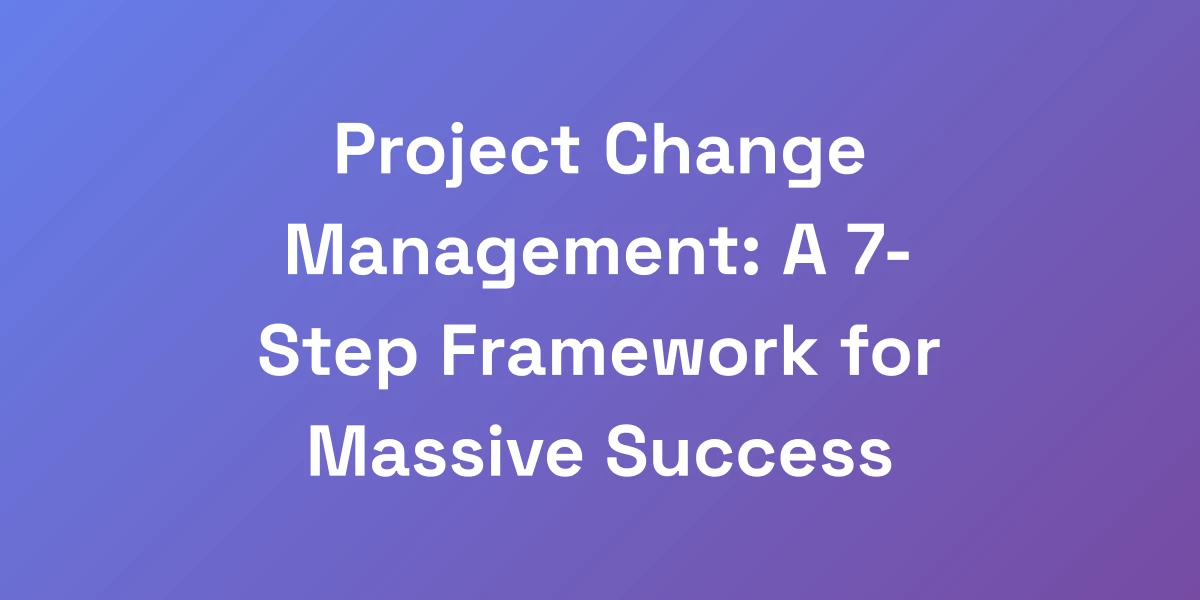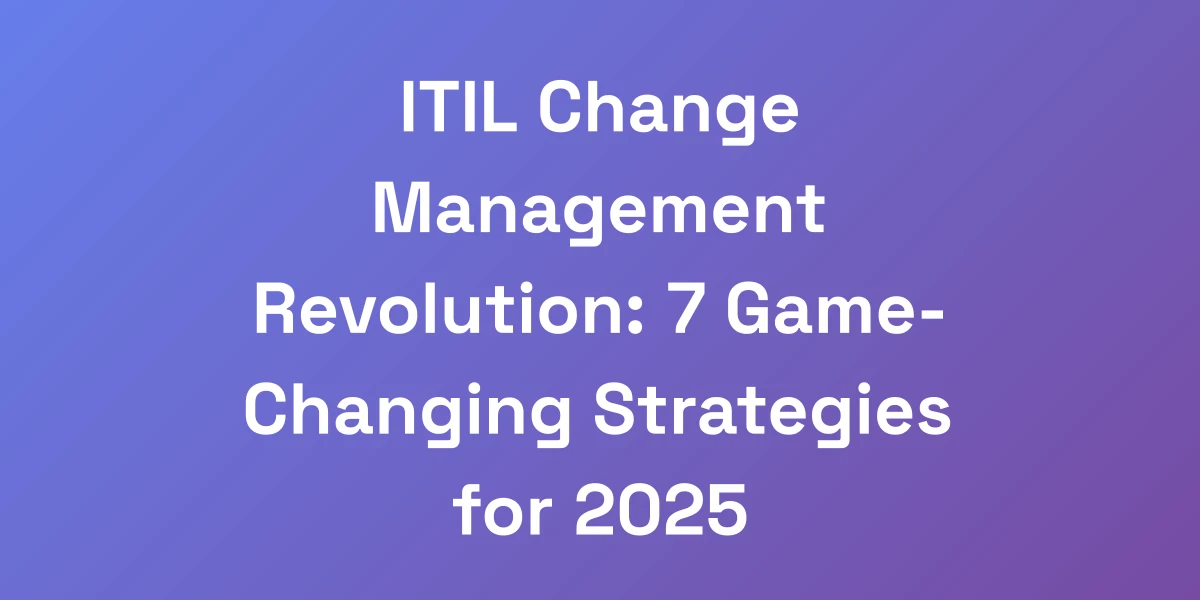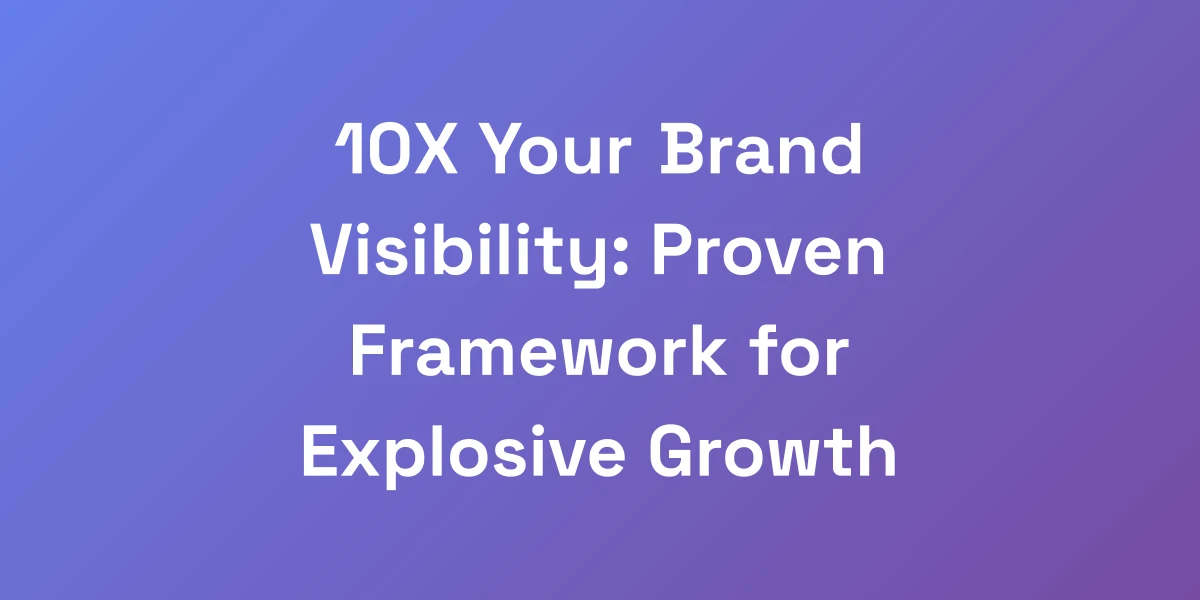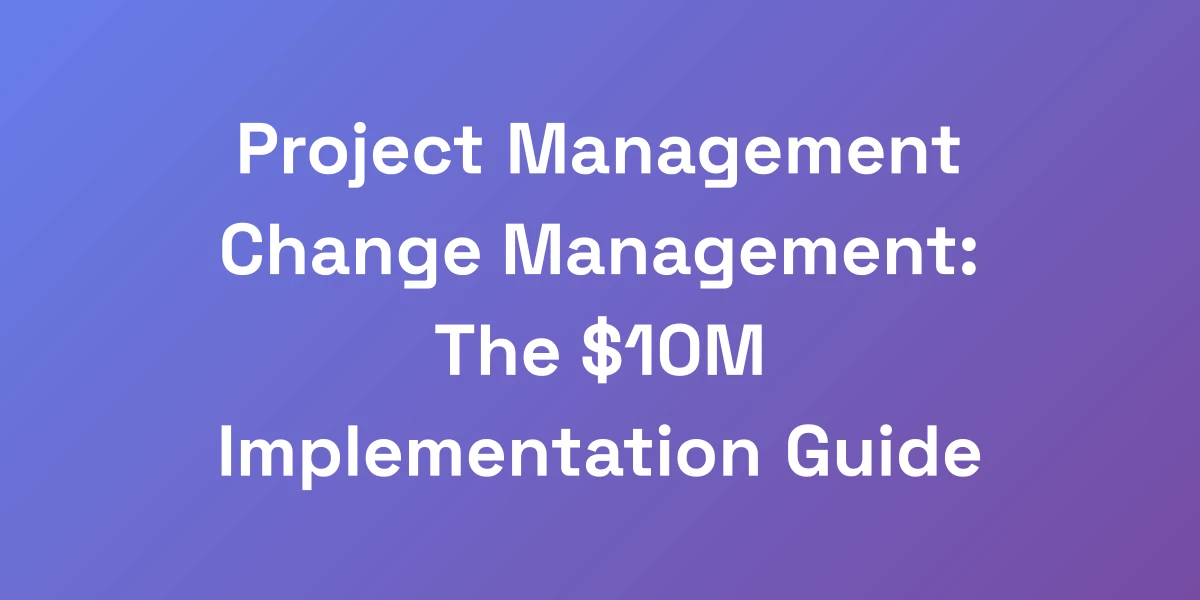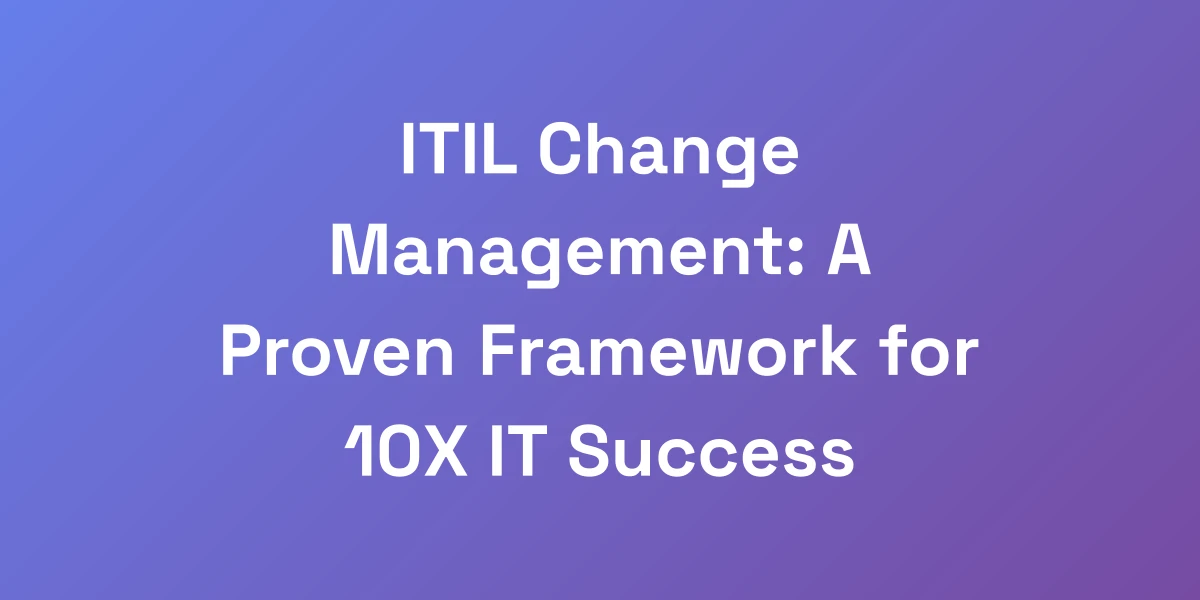
ITIL Change Management: A Proven Framework for 10X IT Success
Mar 17, 2025 | By [email protected]
Understanding the Power of ITIL Change Management
Let me cut through the BS and tell you what ITIL Change Management really is – it’s not just another corporate buzzword. It’s the difference between controlled growth and chaos in your IT operations.
We’ve seen companies burn millions because they didn’t have this framework in place. Think of it as your IT department’s operating system – it determines how efficiently everything runs. When implemented correctly, it’s the difference between a smooth-running machine and a constant firefight.
In today’s rapid-fire tech landscape, why does this matter more than ever? Because every second of downtime or mismanaged change can cost you not just money, but your reputation. So, let’s dive into why ITIL Change Management is your secret weapon for achieving 10X IT success.
The Real Definition Beyond the Jargon
At its core, ITIL Change Management is a structured approach to managing all changes within your IT environment. But don’t let the fancy terminology fool you—it’s about making sure that every change you implement is aligned with your business goals, minimizes risk, and adds value.
Imagine trying to navigate a ship through a storm without any navigation tools. That’s your IT operations without a proper change management framework. ITIL provides the compass, maps, and guidelines to steer your team safely through turbulent waters.
Why Traditional Change Management Fails
Traditional change management often falls flat because it’s too rigid, too slow, and doesn’t account for the dynamic nature of today’s IT environments. It’s stuck in a past where changes were few and far between, not nearly the rapid iterations we witness now.
Most failures stem from inadequate risk assessment, poor communication, and lack of stakeholder engagement. These aren’t just minor hiccups—they’re showstoppers that can derail your entire operation.
In fact, did you know that only about 34% of change initiatives achieve success? That’s a staggering statistic that highlights just how critical effective change management is.
The ITIL Advantage: Risk Mitigation and Value Creation
Here’s where ITIL shines. It’s designed to mitigate risks and maximize value. By following ITIL’s structured processes, you ensure that every change is thoroughly evaluated, approved, and implemented with precision.
For example, consider the Risk Evaluation Matrix—a tool within ITIL that helps you assess the potential impact and likelihood of risks associated with a change. This proactive approach means fewer surprises and more controlled outcomes.
Moreover, ITIL doesn’t just prevent disasters; it actively contributes to value creation by business blogging by optimizing processes and improving service delivery. It turns your IT department from a cost center into a strategic asset.
Key Stakeholders and Their Roles
Successful ITIL Change Management isn’t a one-person job. It requires the collaboration of various stakeholders, each playing a pivotal role.
- Change Manager: Oversees the change management process, ensuring that each change is handled efficiently.
- Change Advisory Board (CAB): A group of experts who assess, approve, and prioritize changes.
- IT Staff: Implement the changes and ensure that they align with technical requirements.
- Business Leaders: Provide strategic direction and ensure that changes support business objectives.
Understanding and clearly defining these roles can prevent overlaps, reduce conflicts, and streamline the change process.
Modern Applications in Digital Transformation
In the era of digital transformation, ITIL Change Management is more relevant than ever. It provides the framework to handle the continuous and often disruptive changes that come with adopting digital marketing for small businesses and other new technologies.
Whether you’re migrating to the cloud, implementing DevOps practices, or integrating AI and machine learning into your operations, ITIL ensures that these changes are managed effectively, minimizing downtime and maximizing benefits.
Consider a company shifting to a hybrid cloud environment. ITIL Change Management would guide each step, from planning and risk assessment to implementation and review, ensuring a seamless transition without disrupting existing services.
The 7 Critical Components of Successful ITIL Change Management
Here’s the truth that nobody tells you: 80% of IT changes fail because people overcomplicate the process. I’m going to show you the seven components that actually move the needle.
These aren’t theoretical concepts – they’re battle-tested elements that I’ve seen transform IT operations from liability to strategic asset. When you nail these components, you create a system that scales with your business growth while maintaining ironclad stability.
Change Request Management and Prioritization
Not all changes are created equal. Effective change request management ensures that every change is documented, assessed, and prioritized based on its impact and urgency.
Start by implementing a standardized change request form that captures all necessary information: the nature of the change, its purpose, potential risks, and resource requirements.
- Categorization: Classify changes into categories such as standard, emergency, or major. This helps in prioritizing and assigning the right level of scrutiny.
- Prioritization Matrix: Use a matrix to evaluate the impact and urgency of each change. High-impact, high-urgency changes should be prioritized to ensure quick and effective handling.
By systematically managing change requests, you prevent bottlenecks and ensure that critical changes receive the attention they deserve.
Impact Assessment Framework
Before any change is approved, it’s crucial to understand its potential impact on the IT environment and the business as a whole. An impact assessment framework helps in evaluating the effects of a change, both positive and negative.
Here’s how to build one:
- Identify Affected Areas: Determine which systems, departments, or processes will be impacted by the change.
- Evaluate Dependencies: Understand how different components interact and identify any dependencies that could affect the change.
- Assess Risks: Analyze the potential risks associated with the change and develop mitigation strategies.
With a robust impact assessment, you can foresee challenges and address them proactively, ensuring smoother implementations.
Risk Evaluation Matrix
Risk is inherent in any change. The Risk Evaluation Matrix is a tool that helps you quantify and qualify risks associated with a change, allowing for informed decision-making.
- Likelihood: Assess the probability of a risk occurring.
- Impact: Determine the severity of the risk if it does occur.
- Risk Rating: Combine likelihood and impact to prioritize risks.
For instance, a change that has a high likelihood of causing downtime and a high impact on business operations would be flagged for immediate action and heightened scrutiny.
By consistently applying the Risk Evaluation Matrix, you ensure that risks are managed effectively, reducing the chances of failure.
Change Advisory Board (CAB) Structure
The Change Advisory Board (CAB) is the nerve center of ITIL Change Management. It’s a group of cross-functional experts who review, assess, and approve changes.
Here’s how to structure your CAB for maximum effectiveness:
- Diverse Representation: Include members from various departments like IT, operations, and business units to provide comprehensive perspectives.
- Clear Roles and Responsibilities: Define the roles of CAB members to avoid overlaps and ensure accountability.
- Regular Meetings: Schedule regular CAB meetings to review pending changes, discuss potential issues, and make timely decisions.
A well-structured CAB ensures that changes are thoroughly vetted and approved by the right people, maintaining the balance between speed and control.
Implementation Planning and Scheduling
Proper planning and scheduling are the backbones of successful change implementation. Without a solid plan, even the best-intended changes can go awry.
- Detailed Implementation Plan: Outline each step of the change process, including timelines, resources, and responsibilities.
- Scheduling: Choose the optimal time for implementation to minimize disruption. Consider factors like peak usage times and maintenance windows.
- Backup Plans: Always have a rollback plan in place in case the change doesn’t go as expected.
For example, scheduling a major software update during off-peak hours can significantly reduce the impact on daily operations, ensuring a smoother transition.
Testing and Validation Protocols
Testing is non-negotiable when it comes to change management. It’s your safety net, ensuring that the change works as intended without introducing new issues.
- Environment Setup: Test changes in a controlled environment that mirrors your production setup.
- Comprehensive Testing: Conduct various types of testing, including unit, integration, and user acceptance testing (UAT).
- Validation Criteria: Define clear criteria for passing tests, ensuring that the change meets all requirements and standards.
Consider a scenario where a new feature is added to your application. Thorough testing will help identify any bugs or performance issues before it impacts end-users, maintaining service quality.
Post-Implementation Review Process
Once a change is implemented, the job isn’t done. A post-implementation review (PIR) is essential to evaluate the change’s success and identify lessons learned.
- Performance Metrics: Measure the change against predefined metrics to assess its impact and effectiveness.
- Feedback Collection: Gather feedback from stakeholders and end-users to understand their experience and any issues encountered.
- Continuous Improvement: Use the insights from the review to refine your change management processes, making future changes smoother and more efficient.
A PIR might reveal that a particular change introduced unexpected latency in the system. By addressing this, you can prevent similar issues in future changes, continuously improving your IT operations.
Implementing Your Change Management Framework in 90 Days
Most organizations take 12-18 months to implement ITIL Change Management. That’s ridiculous. I’m going to show you how to do it in 90 days or less.
The key is focused execution and what I call the “minimal viable process.” Start with the core elements that drive 80% of your results, then iterate and improve. This approach has helped companies reduce change-related incidents by 65% in the first quarter alone.
Week 1-4: Foundation and Planning
The first month is all about laying the groundwork. Define your objectives, assemble your team, and map out your current change processes.
- Define Objectives: What do you want to achieve with ITIL Change Management? Increased efficiency? Reduced downtime?
- Assemble Your Team: Gather a cross-functional team with clear roles and responsibilities.
- Current State Assessment: Analyze your existing change management processes to identify gaps and areas for improvement.
Having a clear plan from the start sets the stage for a smooth implementation, preventing unnecessary delays and confusion down the line.
Week 5-8: Process Development and Tools
Now it’s time to develop the actual processes and select the SEO tools for agencies that will support them.
- Develop Standard Operating Procedures (SOPs): Document each step of the change management process, ensuring consistency and clarity.
- Select Tools: Choose ITSM tools that align with your needs. Automation tools like ServiceNow or Jira can streamline workflows and enhance efficiency.
- Integrate Systems: Ensure your change management tools integrate seamlessly with existing IT systems for a unified approach.
By establishing robust processes and equipping your team with the right tools, you set the foundation for effective and scalable change management.
Week 9-12: Training and Initial Implementation
The final month focuses on training your team and rolling out the initial changes.
- Comprehensive Training: Educate your team on ITIL principles, process workflows, and tool usage. Practical workshops and hands-on sessions can solidify understanding.
- Pilot Implementation: Start with a small-scale pilot to test your change management framework. Use this as a learning opportunity to refine processes before a full-scale rollout.
- Feedback Loop: Collect feedback from the pilot phase to identify and address any issues or inefficiencies.
Effective training and a controlled pilot ensure that when you scale up, your team is ready and processes are optimized for success.
Measuring Success Metrics
How do you know if your 90-day implementation is a success? It’s all about the metrics.
- Change Success Rate: Track the percentage of successful changes with no rollbacks or major incidents.
- Incident Reduction: Measure the decrease in change-related incidents post-implementation.
- Time to Implement Changes: Assess how quickly changes are being approved and implemented compared to before.
Regularly reviewing these metrics provides insights into your framework’s effectiveness and highlights areas for continuous improvement.
Common Pitfalls and How to Avoid Them
Even with a solid plan, things can go wrong. Here are some common pitfalls and how to dodge them:
- Lack of Leadership Support: Ensure that leadership is fully on board and actively supporting the change management initiative.
- Inadequate Communication: Maintain clear and consistent communication across all levels to ensure everyone is informed and aligned.
- Overcomplicating Processes: Keep your processes as simple as possible. Remember, complexity is the enemy of efficiency.
- Ignoring Feedback: Actively seek and act on feedback to continuously refine your change management framework.
By being aware of these pitfalls, you can proactively address them, ensuring a smoother and more successful implementation.
Maximizing ROI Through Automated Change Management
Listen, if you’re not automating your change management process in 2025, you’re leaving money on the table. I’ve seen companies triple their change implementation speed while cutting errors by 80% through smart automation.
But here’s the catch – you need to know exactly what to automate and what requires human oversight. I’ll show you how to strike that perfect balance and create a system that practically runs itself.
Essential Automation Tools and Platforms
Automation tools are the backbone of efficient change management. Tools like ServiceNow, Jira, and BMC Remedy offer robust features for managing change requests, approvals, and implementations.
- ServiceNow: Known for its comprehensive ITSM capabilities, it facilitates seamless change request management and automation workflows.
- Jira: Ideal for Agile environments, Jira integrates chang management with project tracking and development workflows.
- BMC Remedy: Offers advanced automation features, including AI-driven predictions and risk assessments.
Selecting the right tool depends on your specific needs and existing IT infrastructure. The right tool can significantly enhance your change management efficiency.
Integration with Existing ITSM Tools
Automation is only as good as its integration with your current IT Service Management (ITSM) tools. Ensuring that your change management system seamlessly integrates with existing tools like monitoring systems, incident management, and configuration management databases (CMDB) is crucial.
- Seamless Data Flow: Integration ensures that data flows smoothly between systems, reducing manual data entry and errors.
- Unified Dashboard: A centralized dashboard that pulls data from various tools provides a holistic view of your IT environment.
- Enhanced Collaboration: Integrated tools facilitate better communication and collaboration among different teams, ensuring that everyone is on the same page.
For instance, integrating ServiceNow with your CMDB allows for real-time updates on configuration items during change implementations, enhancing accuracy and traceability.
Workflow Automation Strategies
Automating workflows streamlines the entire change management process, from request to implementation. Here are some strategies to consider:
- Automated Approvals: Set up rules that automatically approve routine changes, freeing up your Change Advisory Board (CAB) for more critical decisions.
- Notifications and Alerts: Implement automated notifications to keep stakeholders informed at every stage of the change process.
- Task Automation: Automate repetitive tasks like data entry, status updates, and reporting to reduce manual workload and errors.
Automation not only speeds up the process but also ensures consistency and reduces the likelihood of human error. Additionally, incorporating autoblogging can further enhance your workflow by automating content-related tasks, ensuring that your team remains focused on strategic initiatives.
AI and Machine Learning Applications
AI and machine learning are revolutionizing change management by providing predictive insights and intelligent automation.
- Predictive Analytics: AI can analyze historical data to predict the success rate of changes and identify potential risks before they materialize.
- Intelligent Routing: Machine learning algorithms can route change requests to the appropriate approvers based on past behavior and risk levels.
- Automated Impact Analysis: AI can assess the potential impact of changes on various IT components, providing deeper insights for decision-making.
For example, an AI-powered system might predict that a particular change is likely to cause conflicts with existing configurations, allowing you to address issues proactively.
Cost-Benefit Analysis of Automation
Automating change management isn’t just about speeding things up; it’s a strategic investment that pays off in multiple ways.
- Reduced Labor Costs: Automation reduces the need for manual intervention, freeing up your team to focus on more strategic tasks.
- Fewer Errors: Automated processes are less prone to human error, leading to higher accuracy and fewer disruptions.
- Improved Efficiency: Faster and more reliable processes mean changes are implemented quicker, enhancing overall IT productivity.
Consider the financial impact: large enterprises can lose $6,000 per minute for major service disruptions. By automating and thus reducing the likelihood of such disruptions, you’re safeguarding your bottom line.
Building a Change Management Culture That Sticks
The hardest part isn’t the process – it’s the people. You need to create a culture where change management becomes second nature.
We’ve all been in organizations where resistance to change is rampant. Here’s how to flip the script and foster a culture that embraces change.
It’s about creating what I call “positive friction” – enough structure to ensure quality but not so much that it kills innovation. When you get this right, your team becomes a change enablement powerhouse.
Leadership Buy-in Strategies
Leadership buy-in is non-negotiable for successful change management. Leaders set the tone and drive the adoption of new processes.
- Clear Vision: Leaders must clearly communicate the vision and benefits of ITIL Change Management to inspire and motivate the team.
- Active Participation: Involve leaders in the change management process, making them champions who lead by example.
- Accountability: Hold leaders accountable for the success of change initiatives, ensuring they take ownership and drive results.
When leaders are actively engaged, it signals to the entire organization that change management is a priority, fostering a supportive environment.
Employee Training and Engagement
Training is the cornerstone of empowering your team. Without proper training, even the best processes can fail.
- Comprehensive Training Programs: Develop training sessions that cover ITIL principles, change management processes, and the use of automation tools.
- Hands-on Workshops: Practical workshops where employees can practice implementing changes help to solidify their understanding.
- Continuous Learning: Encourage a culture of continuous learning where employees can stay updated with the latest practices and technologies.
Engaged and well-trained employees are more likely to adopt and advocate for change management practices, driving long-term success.
Communication Frameworks
Effective communication is the lifeblood of successful change management. It ensures that everyone is informed, aligned, and engaged.
- Transparent Communication: Keep all stakeholders informed about upcoming changes, their impacts, and progress updates.
- Feedback Mechanisms: Establish channels for employees to provide feedback and voice concerns, fostering an open and inclusive environment.
- Regular Updates: Use newsletters, meetings, and dashboards to provide regular updates on change initiatives and their outcomes.
Clear and consistent communication helps in managing expectations, reducing resistance, and building trust within the organization.
Incentive Alignment
Aligning incentives with change management goals can significantly boost adoption and enthusiasm.
- Recognition Programs: Acknowledge and reward employees who actively support and contribute to successful change initiatives.
- Performance Metrics: Incorporate change management metrics into performance evaluations to emphasize their importance.
- Career Advancement: Offer opportunities for career growth and development to those who excel in managing and leading changes.
When incentives are aligned with change management objectives, employees are more motivated to embrace and contribute to the process.
Continuous Improvement Cycles
Culture isn’t built overnight; it requires ongoing effort and refinement.
- Regular Reviews: Continuously evaluate the effectiveness of your change management processes and make necessary adjustments.
- Lessons Learned: After each change initiative, conduct a review to identify what worked and what didn’t, applying these lessons to future changes.
- Adapt and Evolve: Stay flexible and open to new ideas, ensuring that your change management framework evolves with your organization’s needs.
By embedding continuous improvement into your culture, you ensure that your change management practices remain effective and relevant over time.
Conclusion
ITIL Change Management isn’t just a framework; it’s the backbone of a thriving IT operation. By understanding its core principles, implementing the seven critical components, and fostering a supportive culture, we’re setting ourselves up for 10X IT success.
Remember, it’s not about going big right away. Focused execution, starting with the essentials and iterating as you go, can transform your IT landscape in just 90 days. Embrace automation, engage your team, and build a culture that not only accepts change but thrives on it.
Are you ready to take your IT operations to the next level? Start implementing ITIL Change Management today and watch your business soar. Share your experiences, ask questions, and let’s build a community of IT excellence together!

